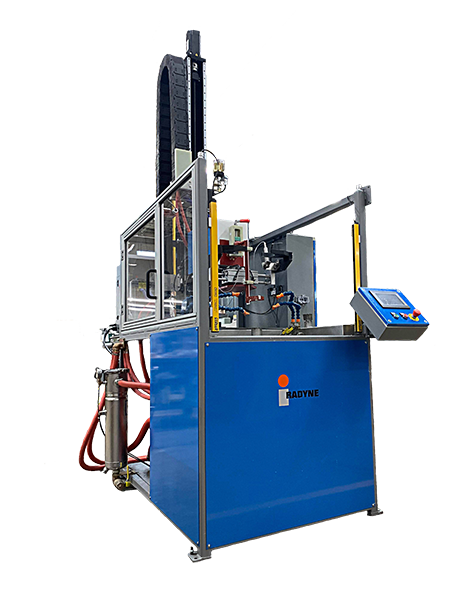Induction Brazing Success
March 18th, 2021

Induction brazing can solve many problems caused by a flame torch or furnace oven, but the beauty of a good braze is just as great as the process itself.
Radyne had the privilege to work on an induction brazing project involving six steel rods brazed together with six rings on a steel platform at the same time. When presented with the project, we referred to our past brazing applications where we heated multiple items at the same time with similar shapes. The IPEC (Induction Process Engineering Center) team decided to tackle the project using Radyne’s Flexscan with a movable heat station. Like all projects, challenges present themselves when you least expect them. One challenge the team faced was positioning the heat station in the right spot. Correct positioning of the heat station was critical to braze the rings unevenly. The ability to program that height was critical to customer success.
The first solution we approached was observing the client heating their parts and we measured the gap from the steel platform to the last turn of the coil. Learning the spacing in between the platform and coil gave even heating for each ring, but the rods were still uneven. The team ran multiple tests to learn why the rods were uneven, including watching the test through a thermal camera. The team discovered the rods were not made the same. The rods turned out to be non-uniform in magnetic permeability, which caused uneven heating. Learning that the parts themselves were unique, we insulated the part from the steel part nest. During the heat cycles, the insulation helped but more was required. Radyne implemented a temperature recipe control method that allowed the part to reach the appropriate brazing temperature, then soak until the entire braze area is brazed evenly. The parts subsequently are cooled off and washed with water.
The next challenge was optimizing the cycle time by increasing how fast the metal heats up. Controlling the rate of heat is just as important as the position of the heat. After many iterations, we decided to approach the challenge like driving a car. A driver will drive 70mph on the highway but will go 3mph going into a garage. That is we heat at high rates until we reach a max temp and then soak. This optimizes braze cycle time.
This induction brazing project was unique because of the magnetic differences within each rod. The unique capability of Radyne’s VersaPower®-Xtreme™ induction power supplies and their Digital-iQ™ induction controls allowed the team to see the impedance difference part to part, to easily illustrate to the customer, the impact of the varying magnetic permeability from their production process on the heating and devise an approach that resulted in customer success.
When handling tough client induction problems, the IPEC team and leadership are transparent and work hand in hand with our clients providing regular updates on issues and progress.




